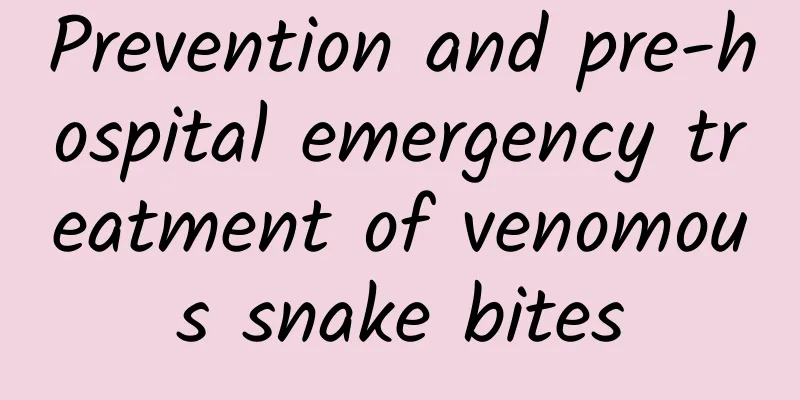Prevention and pre-hospital emergency treatment of venomous snake bites

|
Author: Xiong Shaofeng, The First Affiliated Hospital of Nanchang University Reviewer: Zhou Ying, Chief Pharmacist, The First Affiliated Hospital of Nanchang University The saying "Once bitten by a snake, you will be afraid of the rope for ten years" is enough to express people's fear of snakes. Summer is the peak season for poisonous snakes. In Jiangxi and other regions, people seek emergency treatment every year due to poisonous snake bites. Figure 1 Copyright image, no permission to reprint So, how to prevent snake bites? How to perform first aid after being bitten? Below we will introduce the prevention measures for snake bites and self-first aid after snake bites. 1. Preventive measures for snake bites √ When you are outdoors, wear long clothes, long pants, and high-top shoes, and tie your pants legs tightly. Try not to expose your skin. √ Wear a hat when walking in the woods to prevent snakes hanging from the trees from biting you by touching your neck. √Try not to walk into wild grass. If you have to walk through the grass, you can use a stick to hit it while walking to achieve the purpose of "startling the snake". Figure 2 Copyright image, no permission to reprint √ If you find a poisonous snake at home, it is best not to catch it by yourself. Stay away from the snake immediately and call 110 or 119 to ask professional emergency personnel to come and capture it with professional catching tools. 2. Self-first aid measures for snake bites A snake bite is an acute, complex condition, and time is very precious. Therefore, timely and correct emergency treatment before the arrival of medical personnel is crucial! Here we will introduce the first aid measures after being bitten by a venomous snake. √ Stay calm : Stay calm after being bitten by a venomous snake and remember the snake's appearance. At the same time, try to reduce activity as it will accelerate the spread of venom. Keep the injured limb in a low position to reduce the absorption of venom. Of course, the most important thing is to call 120 emergency number as soon as possible. √ Ligation : Immediately use a rope or cloth strip to tie 5 to 10 cm near the heart end of the wound. The tightness of the ligature is similar to the degree of the compression cuff used when drawing blood for laboratory tests in the hospital, and it must be loosened for 1 to 2 minutes every 15 to 30 minutes to avoid local necrosis due to ischemia of the extremities. √ Extracting fangs : Most of the time, venomous snakes bite people in self-defense. When a venomous snake bites hard and is shaken off, the fangs are likely to break off in the wound. Broken fangs often contain a lot of venom. At this time, the fangs should be extracted as quickly as possible to prevent more venom from entering the body. √ Burning : The main components of snake venom are proteins and polypeptide enzymes, which can be denatured when exposed to high temperatures. Therefore, burning the wound with fire is sometimes the simplest and most effective first aid method [1]. However, it should be noted that if this method is used properly, it will be beneficial to the first aid effect; however, special attention should be paid during the operation to avoid causing secondary injuries. √ Wash with water : Place the wound under clean running water and gently rub the wound to wash away the venom on the skin surface and shallow layers that have not entered the human body. At the same time, gently squeeze the wound surface to expel the toxins and avoid toxin absorption. If there is no water, you can also use your own urine to wash the wound [2]. √ Incision : Use a knife to make an incision in the shape of a “I” or “X”. Do not cut too deep, just enough to seep out blood. Squeeze out some of the blood.[3] √ Send to hospital : After completing the above emergency treatment, wait quietly for the ambulance to arrive. On the way to the hospital, you can use your mobile phone to search for the corresponding venomous snake based on the snake's appearance and physical signs, so that you can accurately inform the doctor when you enter the hospital and use the corresponding serum for treatment. Figure 3 Copyright image, no permission to reprint Of course, if you are sure that the snake that bit you is not poisonous, you don't have to use the above self-help methods. But if you are not sure, it is better to take emergency measures and seek medical attention as soon as possible. References [1] Tang Hanjun. Experience in treating poisonous snake bites[J]. Tianjin Traditional Chinese Medicine, 2010, 27(5): 353-355. [2] Li Qibin, Lü Chuanzhu, Liang Zijing, et al. 2018 Expert consensus on snakebite treatment in China[J]. Snake Journal, 2018, 30(4): 561-567. [3] Zhang Liqing, Zhang Yiqun, Yin Hong. Venomous snake bites[J]. Medical Animal Control, 2006, 22(3): 222-223. |
<<: Leaking urine after childbirth? Try Kegel exercises
>>: How Much Do You Know About Falls in the Elderly?
Recommend
What is the cause of black blood after sex?
Bleeding after intercourse is caused by incorrect...
Is sleep really a way for the brain to detox?
Our brains constantly produce waste, and if too m...
Which gynecological disease is the most serious?
Gynecological diseases are very common in women, ...
How to maintain the uterus?
We all know that the uterus is the most important...
What does high estradiol after transplantation mean?
After embryo transfer, if estradiol is too high, ...
What is the cause of bleeding during sex?
Sexual life is indispensable between couples, and...
Is it normal for vaginal discharge to be like water and have no odor?
Normal leucorrhea will not be too much. If the le...
Abdominal pain but no bleeding during pregnancy
For female friends, pregnancy is a very happy tim...
Girls' genitals pictures
What are the photos of female genitals? In medici...
How much enlargement of the uterus must be removed
How enlarged is the uterus when it must be remove...
Does the head position mean it is in the pelvis?
As the fetus grows slowly over time during pregna...
What will happen if pumpkin cake has too little yeast? How to remedy the situation if pumpkin cake has too little yeast?
Steamed cake is a popular snack in life. It has r...
How did Guan Yu die in the Romance of the Three Kingdoms? Does anyone know how Cao Hong died in the Romance of the Three Kingdoms?
The Romance of the Three Kingdoms uses characters...
What to eat for breast hyperplasia
Breast hyperplasia is a disease that is very comm...
Signs that a woman is more likely to give birth to a daughter
What are the characteristics that make it very ea...









